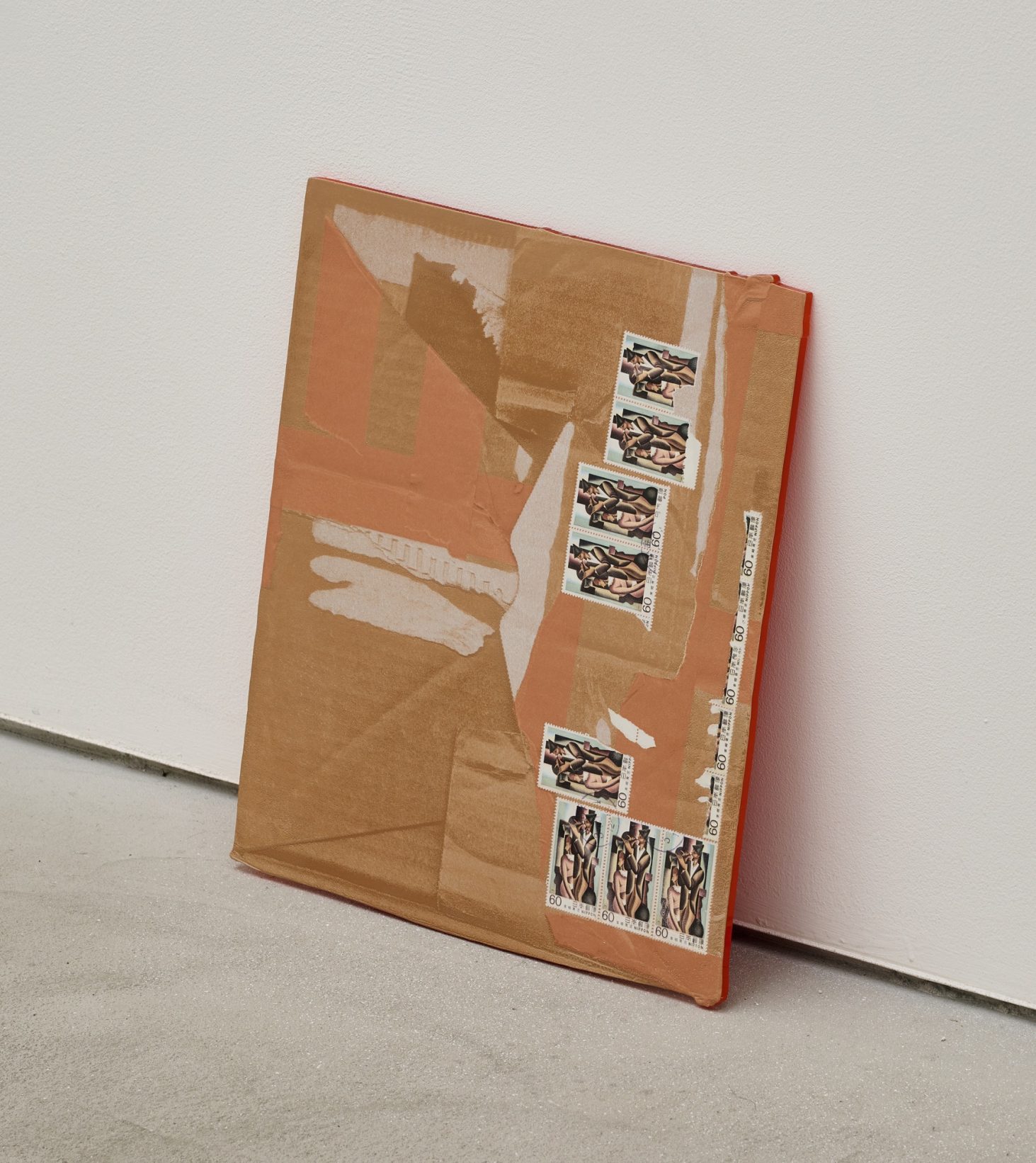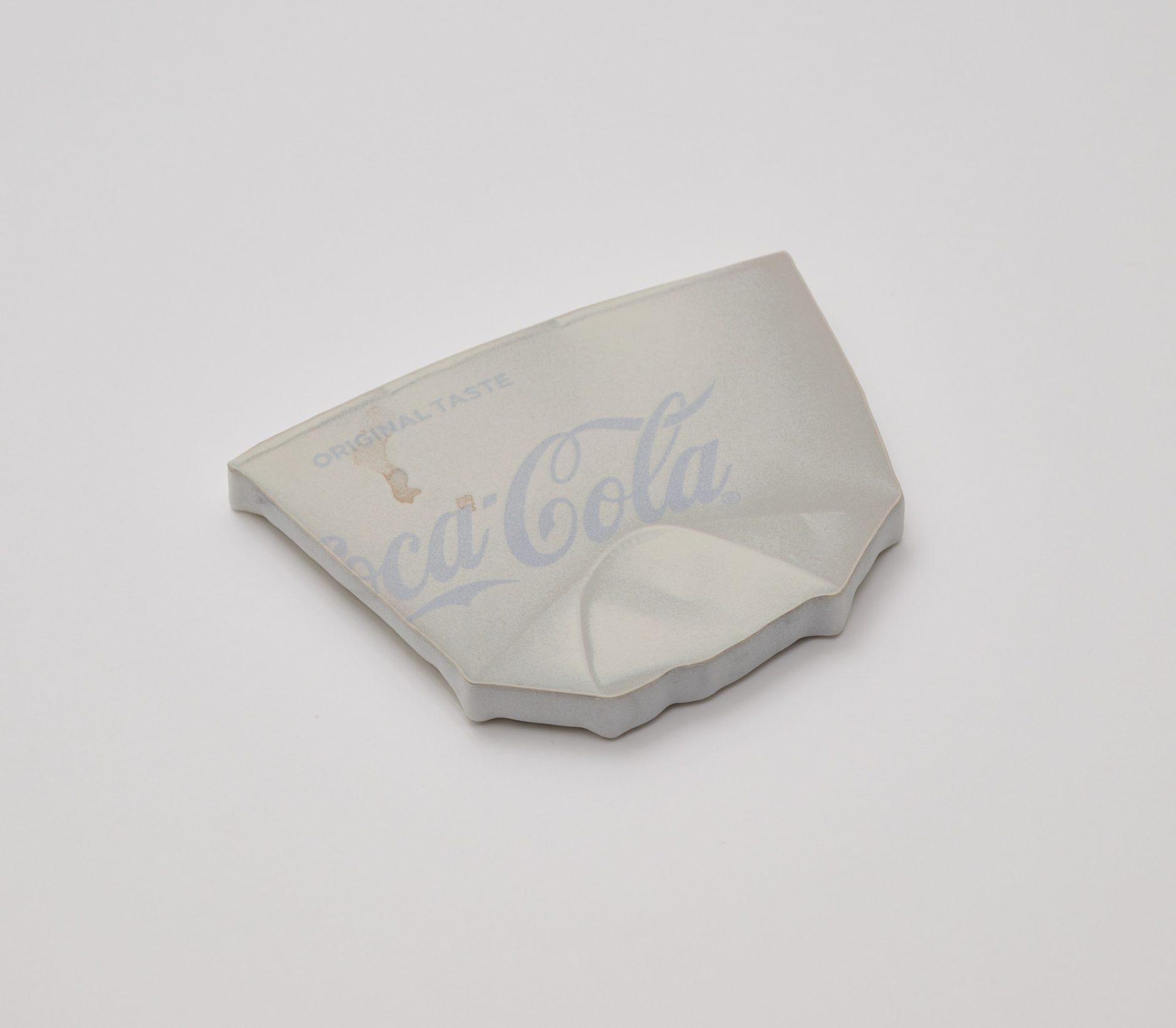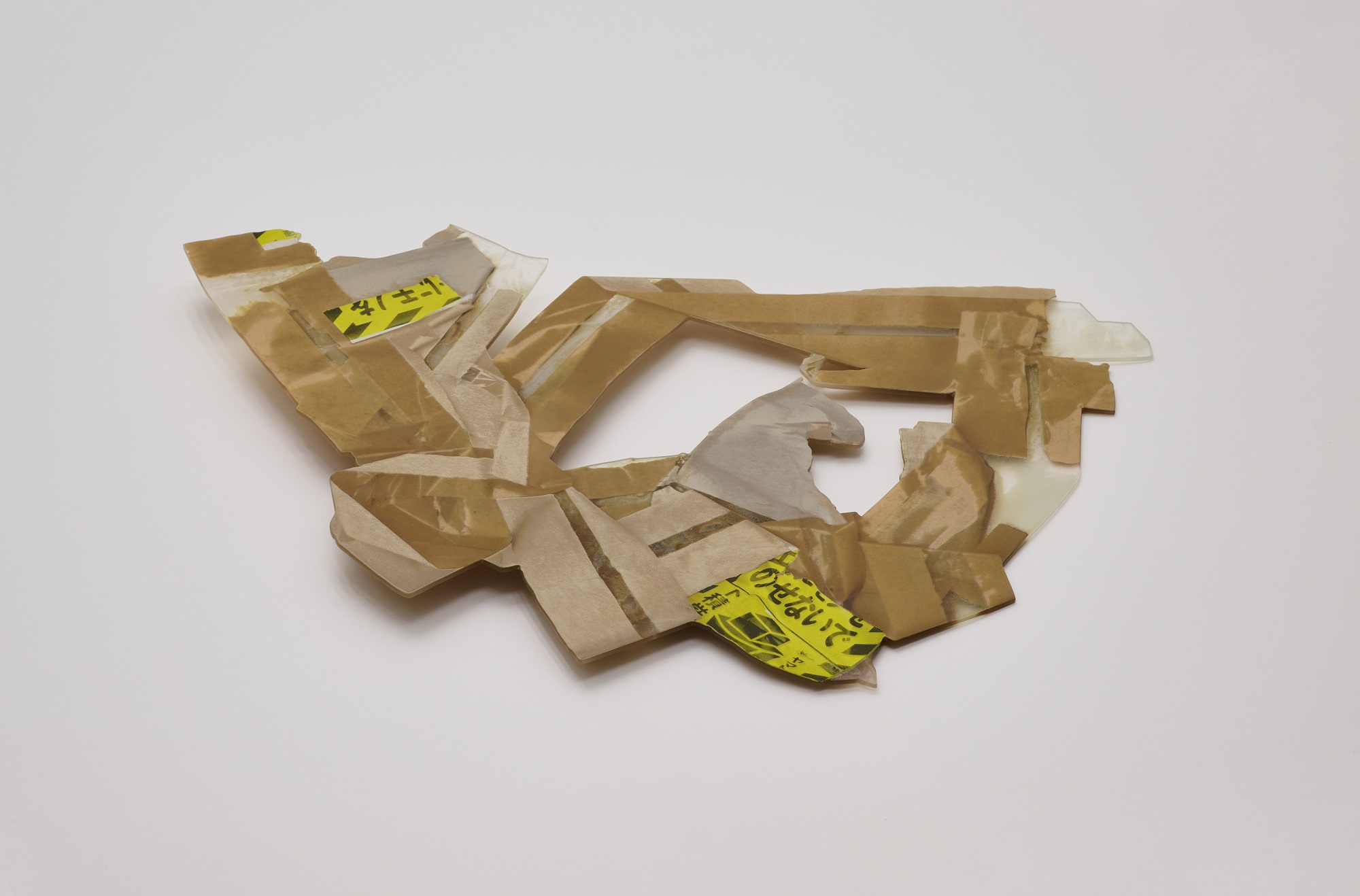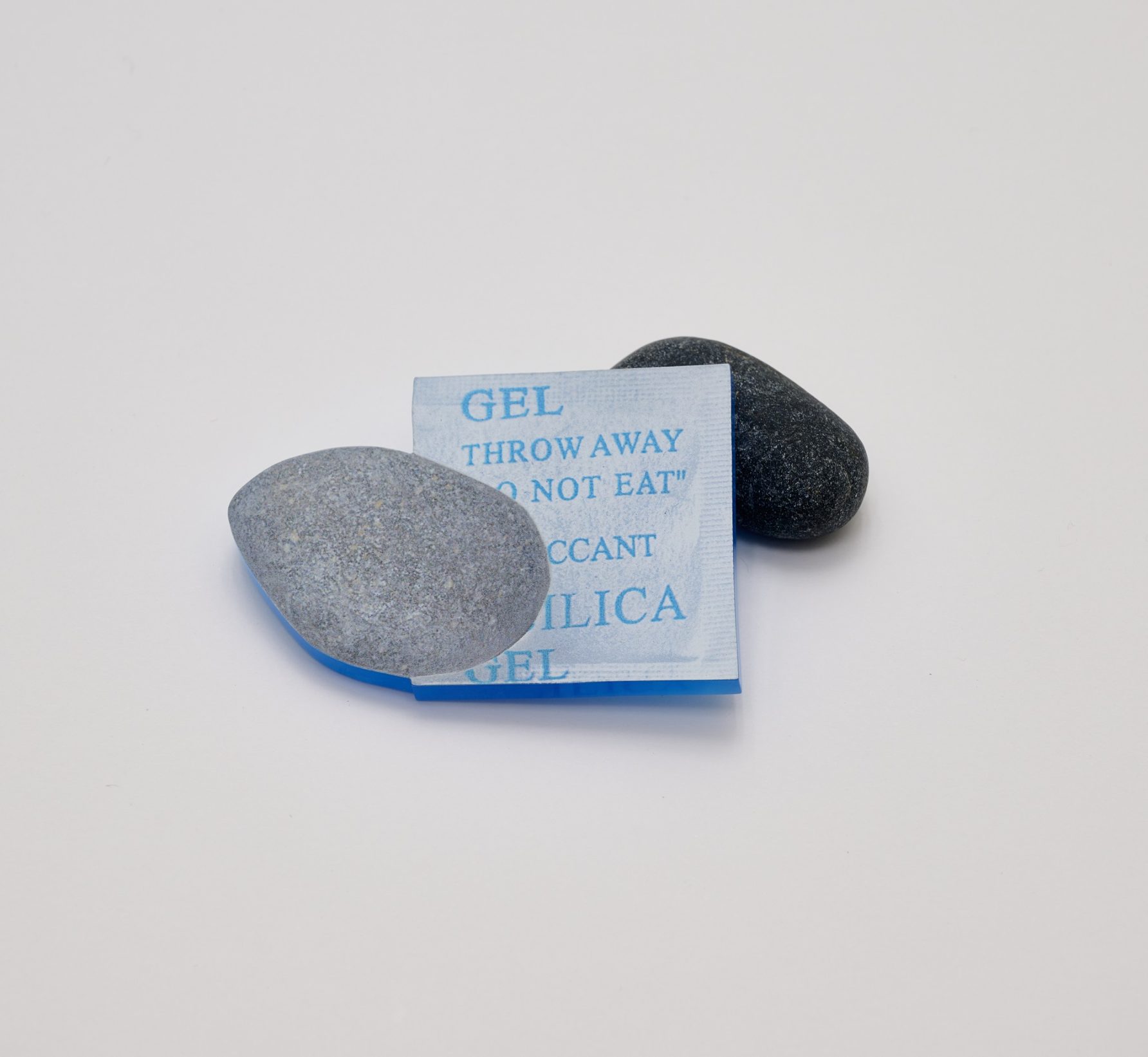Exhibition
Nao Osada : Looking around what’s close at hand
September 9 - October 8, 2023

Packing material(Saltimbanque)
2023
Screenprint, UV inkjet print, acrylic
28 x 33 x 0.5 cm

Stained paper cup(Cola)
2023
Screenprint, marble
9 x 11 x 1 cm

Packing material(tape)
2023
Screenprint, UV inkjet print, acrylic
26 x 37 x 0.2 cm

Silica gel and pebbles
2022
Screenprint, UV inkjet print, acrylic, pebble
4.5 x 6.7 x 0.5 cm
Maki Fine Arts is pleased to present Looking around what’s close at hand, a solo show by Nao Osada, starting September 9 through October 8, 2023 at the gallery’s new exhibition space: B1F, 77-5 Tenjin-cho, Shinjuku-ku, Tokyo (located inside the RUSTIC building)
–
A simple overlap
Takuya Nakao, art critic
There is subject a and subject b. Subjects a and b could both be images or they could both be objects. Alternatively, a and b could be an image and an object or an object and an image.
Nao Osada replicates an <image> of the <already existing> by reproducing it onto a photograph, onto a print, and onto the raw material. The <object> that becomes the raw material is also <already existing>. The image of the <already exiting> becomes a coating, and that coating is reproduced onto the raw material. If we treat <image> as a and <object> as b, the transition occurs as <b (already existing) à a (photographed image) à b (coating) à b (support medium)>. In other words, the condition of Osada’s works of <transfer of preexisting image onto support medium> becomes the combination of <coating> as <(object=image+object)> and <support medium> as <+object>, thus becoming <(b=a+b)+b>.
The <image> that is a is <nonexistent>, and the <object> that is b <exists>. In Osada’s works, however, it is important that the <replication> continues—for example, from the <already existing> motif, to the photograph capturing that certain condition, to that material that would be printed upon being ready-made.
a=image [replication]
In a distinction unnoticed by most, two things become identical, and therefore recognized as a replication. Replication places value in sameness, but, invariably, a distinction will emerge, regardless of whether it is noticed or not. The same images that are displayed and duplicated will change into having a characteristic through ownership.
b=object [replication]
Objects are replicated into two- and three-dimensions through <version> or <type>. A <version> of film, data, and silkscreen is printed onto paper, cloth, and other materials, and material becomes a replica through <type>. The replica made through <version> and <type>, however, will contain misalignments and individual variabilities, i.e., stains, smears, wrinkles, or scratches.
These are accounts regarding the general replication of <image> as well as <object>. In Osada’s works, the <image> of the <already existing> and <ready-made goods> is printed (replicated) as <coating>. At the same time, the <object> of the <already existing> and <ready-made goods> becomes the <support medium>. Then, if all these become replica of the <already existing>, <image of replication=a> becomes <object of replication=b> as coating, and doubly overlaps <object of replication=b> that is the support medium. What Osada ultimately ends up creating is, by overlapping a replication on all a and b in <(b=a+b)+b> which equals <(object=image+object) +object>, a condition where these are recognized (viewed) as one that is <already existing>.
Yet, in most cases, the coating and support medium are not combined as one (for example, the image of the corrugated box will not overlap the object of the corrugated box). While some exceptions exist, often, the <image> and <object> individually assert its status as a replication. We must now consider a separate frame that derives from the overlap of replica <image> and replica <object>.
a’=image [readymade]
Readymade was given context in the art world and carries a wide interpretation. Instances of Marcel Duchamp reproducing readymade shadows onto photographs, Andy Warhol reproducing readymade designs onto prints, and Peter Fischli and David Weiss reproducing readymades onto other materials indistinguishable from the original come to mind.
b’=object [readymade]
Readymades themselves have characteristics as individual mediums. Just as a tube of paint placed on canvas becomes a painting or an image transferred on print paper becomes a photograph, an image becomes a piece of work when reproduced onto a different medium or support medium, i.e., paper, cloth, wood, rock, metal, acrylic, mirror, glass, window, a part of a building, etc.
At the overlap of the <already existing> <image> and <object>, an overlap of visual lines occurs between the ready-made goods <a+b> as non-art and the readymade <a’+b’> as art. Therefore, at the overlap of replication called <(b=a+b)+b>, a potential will exist for a frame called <A{(b=a+b)+b}+B{(b’=a’+b’)+b’}> which overlaps <ready-made goods> A=non art and <readymade> B=art.
Osada selects <ready-made goods/readymades> of objects a and b, photographs a, and prints it on b to create a new <image/object>. And most importantly, while that image is used as <ready-made goods/readymades>, it is considered more as one that would be discarded. More precisely, the visual line is cast toward the trace of what would be discarded.
Scattered here and there within the <already existing> images selected by the artist are those that further emphasize the periphery of the replication—for example, those that <envelope>, <support>, or <enveloped>, <supported> the ready-made goods content. In addition, the coating and support medium distinctly overlaps as different mediums. This is when that image of the trace has the appearance of A=non art, yet, in the sense that the selected medium is used as a support medium and reproduced, it reveals the condition of it being B=art. (While the selection of medium is arbitrary, in the sense that it has been deprived of its practicality, artistry in the art world appears.) In this manner, all characteristics including stains, smears, wrinkles, and scratches are moved to the position that overlaps <trace=tache>.
The coating and support medium are united on a <plane>. Its <painting=2D>-like stains and smears and <sculpture=3D>-like wrinkles and scratches remain in 2D instead of becoming 3D. Moreover, they are reproduced onto the support medium as an <illusion> that is <painting-2D>-like in which the 3D-ness has been copied. When this happens, the replication as imitation (mimesis) is the visualization (2D-ness) of the object which reproduces <ready-made goods/readymades> that contains <trace/tache>, as well as being the materialization (3D-ness) of the image by way of being reproduced on a separate medium. In both the day-to-day (life) and the art (production) in which painting- and sculpture-like <contents> are enveloped, supported, and discarded, this work process is made by way of the <already existing> <image> and <object> located at the edge—not at the center but on the periphery. For this reason, by incorporating the <life/production> cycle of daily life into non-art=A as a nested structure, and by not fixing the visualization or materialization of B=art, it can also be returned to A=non-art.
In this manner, Osada’s works rotates non-art and art where the frames of non-art and art for <ready-made goods/readymades> and <A{(b=a+b)+b}+B{(b’=a’+b’)+b’}> overlap: in the way <trace> that is A=non-art becomes B=art, and tache that is B=art becomes A=non-art. The <characteristic of an image as a work of art>—the normal position of <original> and <copy> or <aura> and <non-aura>—and what supports it—<plurality of the support medium as a replicate>—reverses positions. In other words, it becomes <B[A{(b=a+b)+b}+B{(b’=a+b’)+b’}]+A[A{(b=a+b)+b}+B{(b’=a’+b’)+b’}]>. What results is an overlap of conditions providing characteristic to <plurality of the support medium as a replicate> as well as providing plurality to <characteristic of an image as a work of art>. Just like a print misalignment, and just like the individual variabilities found in ready-made goods. There is subject a and subject b; on that simple overlap.
–
Nao Osada
Born 1988, Nao Osada received her MFA from Tokyo University of the Arts.
Notable shows include, The Constitution of Japan (group, MUJIN-TO Production, 2023), Medium and Dimension Liminal (group, Kakinokisou, 2022), At Least One (solo, Maki Fine Arts, 2022), Playground for the Senses (group, ANB Tokyo, 2022), I see (solo, NADiff Window Gallery, 2022).

